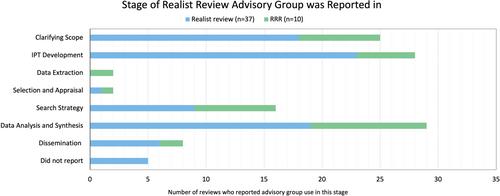Advisory groups in realist reviews: Systematically mapping current research and recommendations for practice
Abstract
Introduction
Realist reviews may involve groups or panels external to the research team who provide external and independent perspectives informing the review based on their experience of the topic area. These panels or groups are termed in this study as an “advisory group.” This study aims to map current practice of advisory groups in realist reviews and provide guidance for planning and reporting.
Methods
A “best-fit” framework synthesis methodology was used by first searching for a best-fit framework and then conducting a systematic search to identify a sample of realist reviews and rapid realist reviews (RRRs) from the most recent year, 2021. Nine databases were searched: CINAHL Complete, Cochrane, Embase, ERIC, MEDLINE, PsycInfo, Social Services Abstracts, Sociological Abstracts, and Web of Science Core Collection. Screening and data extraction was conducted by two researchers. The chosen best-fit framework (ACTIVE framework) informed the data extraction tool.
Results
One hundred and seven reviews (93 realist reviews, 14 RRRs) were identified for inclusion. Of these, 40% (n = 37) of realist reviews and 71.5% (n = 10) of RRRs mentioned use of an advisory group, though there was considerable variation in terminology used. Individuals in advisory groups were involved at varying stages of the review and tended to bring experience in the topic area from the perspective of (i) a lived experience, that is, patients, carers, family members (n = 15 realist reviews; n = 4 RRRs); (ii) professional experience, such as healthcare professionals (n = 20 realist reviews; n = 6 RRRs); or (iii) policy or research experience in the topic area (n = 19 realist reviews; n = 7 RRRs).
Conclusions
This study proposes a definition of advisory groups, considerations for advisory group use, and suggested items for reporting. The purpose of the advisory group should be carefully considered when deciding on their use in a realist review.


 求助内容:
求助内容: 应助结果提醒方式:
应助结果提醒方式:


